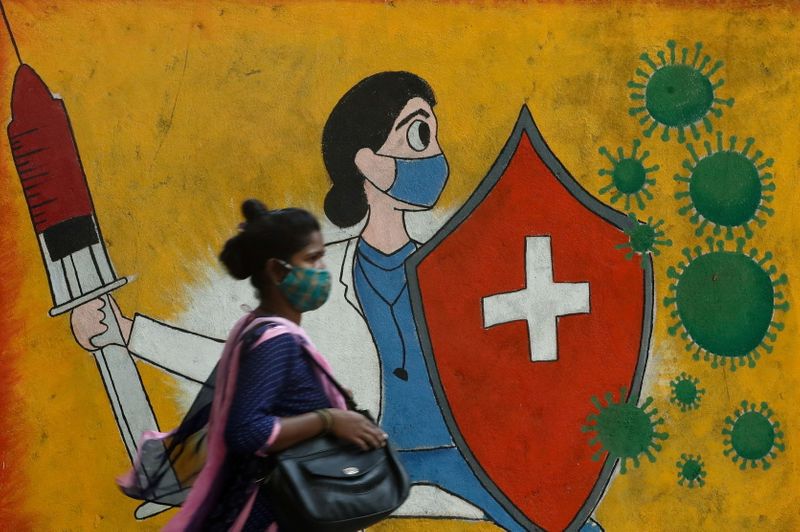
Explainer-What is ‘black fungus’ that is hitting India’s COVID-19 patients? By Reuters

© Reuters. FILE PHOTO: A woman walks past a graffiti on a street, amidst the spread of the coronavirus disease (COVID-19) in Mumbai, India, May 10, 2021. REUTERS/Francis Mascarenhas
(Reuters) – A rapid rise in cases of mucormycosis, also known as black fungus, has added to the challenges faced by India’s healthcare system as it deals with a massive second wave of COVID-19 infections.
The following lays out information about mucormycosis, opinions from health experts and the scientific evidence behind what could be driving the recent rise in cases.
WHAT IS MUCORMYCOSIS?
Mucormycosis is a fungal infection that causes blackening or discoloration over the nose, blurred or double vision, chest pain, breathing difficulties and coughing blood.
The disease has a close link to diabetes, and conditions which compromise the immune system. Experts have said that an overuse during the COVID-19 pandemic of certain drugs which suppress the immune system could be causing the surge.
Data from the U.S. Centers for Disease Control and Prevention shows that mucormycosis has a mortality rate of 54%, which can vary depending on the condition of the patients and the body part affected.
States across India have reported more than 5,000 cases of the otherwise rare disease in recent weeks, mostly in people infected with COVID-19 or recovering from the disease.
IS IT CONTAGIOUS?
The disease is not contagious, which means that it cannot spread from contact between humans or animals. But it does spread from fungal spores that are present in the air or in the environment, which are almost impossible to avoid.
“Bacteria and fungi are present in our bodies already, but they are kept in check by the body’s immune system,” said K Bhujang Shetty, head of Narayana Nethralaya a specialty eye hospital. “When the immune system goes down because of cancer treatment, diabetes or use of steroids, then these organisms get an upper hand and they multiply,” said Shetty.
IS THE USE OF UNSANITIZED OXYGEN CYLINDERS OR VENTILATORS CAUSING THE OUTBREAK?
It’s hard to say.
Experts say that unsanitary conditions could increase the risk of developing the infections.
“There is a lot of contamination in the pipes used for oxygen, the cylinders that are being used, the humidifiers used,” said Nishant Kumar, an ophthalmologist at Hinduja Hospital in Mumbai.
“If you are immuno-suppressed, and you have been on these pipes and oxygens for a long period of time, then these infections get much more of an opportunity to get in.”
But opinion is divided on this point.
“Hospitals were dirty even before April. We need epidemiological studies to assess why these cases are rising now,” said S.P. Kalantri, senior doctor and researcher at the Mahatma Gandhi Institute of Medical Sciences in Maharashtra.
WHY MUCORMYCOSIS AND NOT OTHER FUNGAL INFECTIONS?
COVID-19 has been associated with a wide range of secondary bacterial and fungal infections, but experts say India’s second wave of COVID-19 has created a perfect environment for mucormycosis.
Low oxygen, diabetes, high iron levels, immuno-suppression, coupled with several other factors including prolonged hospitalization with mechanical ventilators, creates an ideal milieu for contracting mucormycosis, researchers wrote in the journal Diabetes & Metabolic Syndrome: Clinical Research & Reviews.
Stay connected with us on social media platform for instant update click here to join our Twitter, & Facebook
We are now on Telegram. Click here to join our channel (@TechiUpdate) and stay updated with the latest Technology headlines.
For all the latest Education News Click Here
For the latest news and updates, follow us on Google News.

